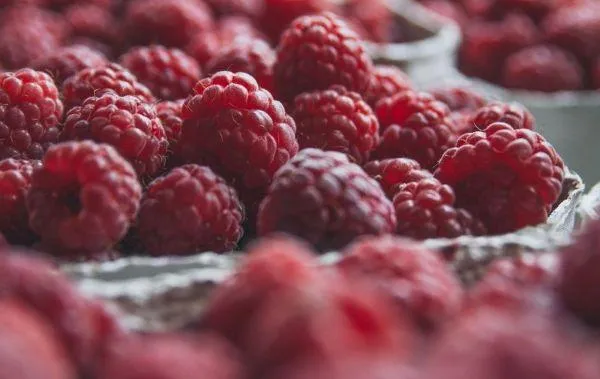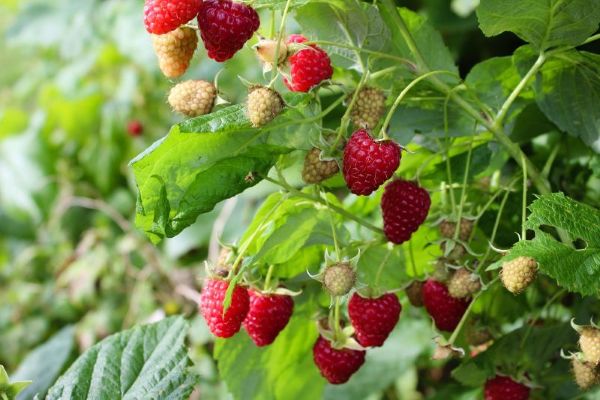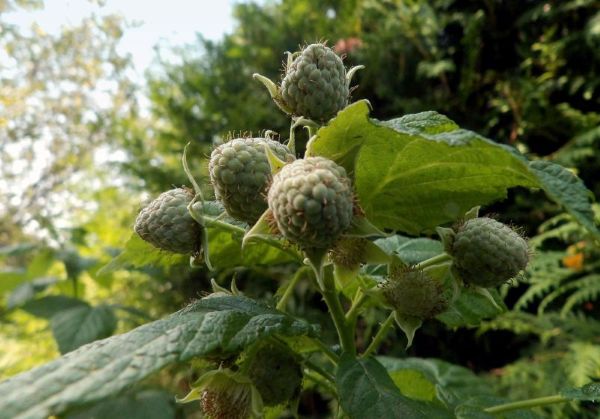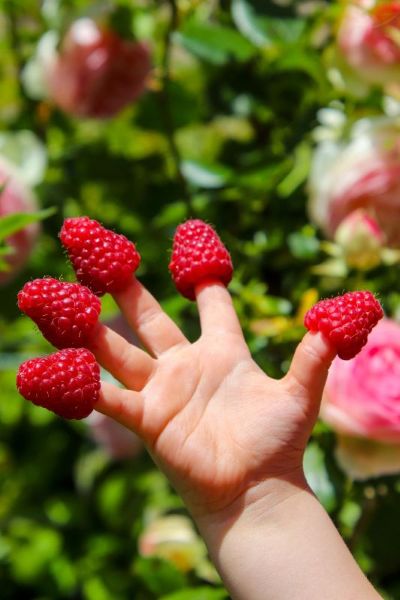
Your Backyard Fruit Bowl – Raspberries
Imagine a world, in which your entire possession is one raspberry, and you give it to your friend.
- Gerda Weissmann Klein, Polish-American writer and human rights activist.
Raspberries: a short family history
Suitable climates and growing conditions
I think raspberries are one of the most iconic summer fruits – with their heady aroma, soft, delicate texture, and unmistakable height-of-summer sweet-tart berry flavour, one can forgive them for their scratchy nature. Despite the high price you’ll pay for this fruit on the supermarket shelf, and their shockingly short shelf-life, raspberries are super simple to grow at home, and ah, once you plant them, you’ll never be without them…
I misguidedly planted a few canes in a corner of the vegetable garden in space-related desperation a few years back. In late winter last year, with the original patch having tripled in size, I relocated half the plants to (another) unsuitable spot, where they found their next calling as goat tucker. I needn’t have worried, as in their place back in the vege garden, another crop of robustly healthy canes grew over spring and early summer. In terms of relocation, I’m nearly back to square one.
One of the best things about raspberries is that given their diversity in regards to growth, you can have continuous bowls of berries from December right through to April by taking advantage of their various fruiting habits. I’m still trying to figure out which cultivar the super-sized berries that I enjoyed at a bed and breakfast in Napier a decade ago were – definitely autumn-fruiting and the biggest I’ve ever eaten, with excellent flavour. The double cropping, New Zealand-bred ‘Aspiring’ matches their timing of fruiting, but these berries were squat rather than conical and tapering. Given the time that’s elapsed, I’m not much of a detective - nothing like a bit of ongoing mystery and intrigue though, I guess.
If you’ve got a bit of space and the inclination to plant some raspberry canes in a sensible spot and (preferably) contain your crop, a patch of raspberries can bring infinite pleasure and low-maintenance, healthy sweet treats all summer and autumn long (unless you’re like my poor friend who has a raspberry allergy – she can’t even be in the same room as them).
Raspberries: a short family history

Ripening raspberries: Image by Ieva Karklinaa pixabay.com
Rubus idaeus, the red raspberry is yet another member of the extremely fruitful Rosaceae family. Close relatives include blackberries, dewberries and the Japanese wineberry, and of course there are a multitude of hybrids between these, giving rise to popular berries in their own right, such as boysenberries, tayberries and loganberries. There are also an astounding number of raspberry variants, including the cold-hardy Arctic raspberry of northern Europe, Rubus arcticus; the Ceylon raspberry hailing from eastern Asia; and the bush lawyers of Australasia, including our own incredibly diverse, endemic tātarāmoa species: Rubus cissoides, R. schmidelioides, R. parvus, R. squarrosus and R. australis. Many a tramper will be well-acquainted with the skin-shredding qualities of some of these native bush inhabitants, although the fruit they produce is more likely to form a snack for passing wildlife than hungry adventurers.
R. idaeus is native to southwestern Europe and the old Asia Minor (now part of Turkey). Cultivated in Greece for at least 2000 years, the species was likely found growing on the slopes of Mount Ida, giving rise to the Latin species epithet ‘idaeus’. From here, the fruit probably dispersed via the Roman trade routes to the rest of Europe and Britain, where selective breeding has taken place over the centuries.
R. idaeus, as with its bramble relatives, produces aggregate fruits, which aren’t true berries in the botanical sense but collections of lots of little individual fruits called drupelets – each flower’s receptacle consists of tens of individual embryos, all capable of developing into drupelets with their own central seed. With raspberries, the receptacle stays behind when the fruit is picked, leaving the characteristic hollow centre that lends the raspberry so well to the childhood delight of fingertip adornment and satisfying snacking, unlike with blackberries and boysenberries, where the receptacle remains attached and the fleshy core is consumed with the rest of the fruit.
Not just a delicious fruit, as a source of ellagic acid, an anti-carcinogenic antioxidant; salicylic acid, the active constituent of aspirin; possessing the ability to inhibit the formation of low-density lipids (so-called ‘bad cholesterol’) and having positive effects on blood sugar, raspberries are a very beneficial addition to the human diet. Raspberry leaf tea has long been utilised as a tonic for women of childbearing age and is also used to alleviate mouth issues such as ulcers, gum problems and sore throats.
Suitable climates and growing conditions

Green raspberries: Image by Adam Friedrich from pixabay.com
Raspberries grow well in most areas of New Zealand, but do require some winter chilling to set a good crop. 400-500 hours below 7°C is the absolute minimum required, but somewhere in the range of 800-1600 hours is optimal. Areas such as Northland may experience less reliable levels of fruit set because of this. Areas with cool autumn conditions and reasonably cold winters to promote bud initiation, ideally followed by cool, dry spring conditions (especially at flowering – dampness then can hamper pollination and fruit set) and warm but not overly hot summers for ripening are the gold standard.
I’ve read lots of recommendations for providing some sort of support system when establishing a raspberry bed, be it a single wire system that you can tie individual canes to (try wooden posts with two strands of wire attached at 0.7 and 1.4 metres in height) , or a double parallel wire fence system that the canes can be grown between – absolutely necessary for tall cultivars. I’ve also seen such structures used frequently and with great success in commercial operations, where they also assist when machine harvesting is employed. Others suggest growing raspberries up against a wall, but I guess I’ve always taken a rather relaxed approach and just planted freestanding clumps. There is definitely benefit from planting in an area that is easily accessed from all sides at harvest, handy when you need to throw a bird net over the top as well – another situation where a wire framework would be beneficial, helping to push the net clear of the canes and marauding birds who might make the most of an easy vantage point for swinging in and out to sample the ripening crop.
Clumps of two to three canes are the standard planting unit; allow 30 to 40 cm space between plants within a row, and 1.5 to three metres between rows of plants if planting a large area. Much less than this, and overly vigorous plants may start to lean over, entangle themselves, and like all brambles, take root anywhere trailing canes touch the ground – an unpleasant trip hazard for the unsuspecting.
Raspberry plants are relatively long-lived on the whole, you’ll probably want to look at replacing and reinvigorating your stock after around 15 years of cropping. The canes themselves lose their fruitfulness after their second year and are constantly being renewed; more about this in the pruning section.
Although fruit can be produced relatively soon after new plants go in the ground, it takes two to three years for bushes to reach full production. Average yield at maturity is approximately 1 kg/plant and ripe berries are produced over a substantial picking window, with fruits within clusters ripening individually at different times, requiring staggered successive harvests. Raspberries are self-fertile and their nectar-rich flowers are insect pollinated, a popular food source for bees and other insects. Planting several varieties, or at least a decent number of plants of the same variety in close proximity can help increase yield via cross-pollination.
Raspberries are easily propagated by digging up suckers from alongside parent plants in autumn and winter. If you’re after a certain variety, head to your local garden centre or nursery, but if you have friends with a raspberry patch, they will probably pay you to come and remove their excess plants! It never ceases to amaze me how far the roots of one raspberry plant can travel.
Site selection and planting
Plant your raspberry patch in autumn or early winter. Choose a sunny but sheltered spot, as raspberry plants have quite thin leaves which are susceptible to wind damage and the plants don’t tolerate exposure to salt spray either.
Raspberries do best in well-drained, sandy loam soils of reasonably high fertility and pH of around 4.5 – 7.0. They have a very fine, fibrous root system with a few deeper tap roots (which become apparent when digging up suckers). Avoid heavy clay soils that are prone to waterlogging and avoid planting raspberries in low-lying ground prone to flooding as they are highly susceptible to root rots. The addition of compost to lighter soils is beneficial not only for fertility but also boosting water holding capacity.
Trimming newly-planted canes down to 20-30 cm in height above soil level is promoted to encourage development of a strong root system in the establishment phase.
This article is part of our Backyard Fruit Bowl series
Start here for a full overview of growing fruit on lifestyle blocks.
Culture and care
Because the majority of the raspberry plant’s roots are located at a relatively shallow depth, avoid deep cultivation – applying a layer of mulch is often a better approach for inter-row weed control as opposed to mechanical cultivation, with the added benefit of aiding soil moisture retention and a dose of nutrients at the same time.
Raspberry plants need a good supply of water throughout the growing season and consistent irrigation is particularly important during fruit formation. Apply water close to the soil surface and avoid blasting it upwards into the canopy as this will exacerbate the prevalence of fungal diseases.
In terms of fertiliser, you can choose to apply an organic compost or a side dressing of balanced general fertiliser (100 – 150 g per mature plant) in spring. Spread inorganic fertilisers evenly around the base of the plant and water in well or apply prior to forecast rainfall. Avoid applying excessive amounts of nitrogen-rich fertiliser as this can tip the balance of plant growth towards an overabundance of vegetative growth at the expense of flower and fruit production, and can contribute to dense, humid canopy conditions that may exacerbate disease pressure.
Pruning
Raspberries are grouped into summer fruiting and autumn fruiting varieties, and although some may produce crops spring and autumn, one is the main crop and the other noticeably smaller. The pruning methods are slightly different for each.
Summer fruiting raspberries crop best in cooler areas and only produce fruit on two-year old canes. Easily identifiable fresh, new green canes grow in the spring and are called primocanes – these remain vegetative for the first year and form flower buds in late summer. The canes then go dormant for winter and lose their leaves. The following spring, these canes (now in their second year and termed floricanes) burst into life, the buds producing flowers and fruiting in summer. They then die back and become redundant in the winter that follows, and are removed at ground level. It’s also a good idea to remove any diseased or damaged canes at this point too, and thin out the row if the canes are becoming crowded. A congested canopy restricts the airflow which is all-important for maintaining disease-free conditions.
Autumn-fruiting raspberries are sometimes called everbearing raspberries and are often better-adapted to warmer climates. They produce their largest crop in the autumn, fruiting on the current new season’s growth, which is sometimes tipped during the growing season to encourage the development of fruiting laterals. The canes can then be removed at ground level in the winter that follows, or if left, they may also produce a small crop again the following spring, after which they are pruned out at ground level.
It's considered good crop husbandry to burn all spent raspberry canes after pruning to prevent the proliferation of pests and diseases.
Pests, diseases and what to do about them
Raspberries are susceptible to all the maladies their other bramble cousins are afflicted by.
Fungal diseases, e.g., Anthracnose can cause spotting and lesions on leaves and canes. Botrytis (grey mould) becomes a problem when ripening fruit is affected by rain. Good canopy management (for adequate airflow and light penetration) and crop hygiene – removing and destroying old and/or diseased plant material will help.
The main insect pests you’re likely to encounter are raspberry bud moth, scale insects and leafroller caterpillars. The latter like to stitch leaves up into a webbing-bound mass – digital biological control (removal and squishing via fingers) may be all that’s required to keep small populations in check.
It’s likely that in the home garden, you don’t want to embark on a heavy-duty spray programme. For insect pests, try and maintain the natural diversity in your garden and provide a hospitable habitat for the natural enemies of common pest insects – try planting strips of buckwheat nearby, as its nectar-rich flowers are great for supporting populations of parasitic wasps that lay their eggs inside pesky leafroller and bud moth larvae.
If you have major disease problems, you can try a lime sulphur spray in late winter (this will also help deal to scale insects) and a copper spray (e.g., Yates Copper Oxychloride) just as the buds begin to move to help with fungal diseases – follow the label directions. Practice good crop hygiene and burn all spent canes after pruning and disinfect your tools by spraying with methylated spirits after use.
If, unlike me, you can keep marauding four-footed livestock from chewing your canes to bits, birds will be your other (or should I say, the major) pest. Net your crop well before it’s ripe or face 100% loss. If you’ve planted a wide bed with easy access all around, throw some recycled vineyard bird netting over the top and call it a day.
Varieties: My top picks

Raspberry fingertips: Image by Blandine JOANNIC from pixabay.com
Heritage – an autumn fruiting variety with firm, well-flavoured fruit. Canes will produce again the following spring, cut them back by one third once fruit is harvested to encourage this second fruiting. Produces strong-growing canes which don’t require additional support.
Aspiring™ – autumn fruiting and will also crop again the following summer, producing large dark red conical firm fruit with an excellent flavour.
Tulameen – a summer fruiting raspberry, popular with commercial growers and home gardeners alike. This variety has very long canes, which shouldn’t be cut back the first year at planting, but left to develop fruit-bearing side shoots at the top of each cane. These will flower and fruit in the first season after planting, as well as producing new growth (the following year's fruiting wood). Produces sizeable yields of large, well flavoured berries in mid-summer. Prune as for all summer raspberries in subsequent years.
Mini-Me™ - a thornless, dwarf summer-fruiting raspberry with a compact, rounded growth habit. Part of the Incredible Edibles range, it is suitable for container growing on a deck or patio with no staking or support necessary. Produces full-sized, sweet raspberries in December-January.
Black and yellow/white-fruited raspberry cultivars are now widely available too, call me biased but I’m yet to find one that measures up to a good red raspberry flavour-wise.
What to do with your crop
Raspberries are one of those obligingly easy berries to preserve. They freeze exceptionally well - I advise freezing them in a single layer on a tray, then bagging free flow for easy removal in small quantities later. If you have a massive glut and want to make bulk jam or sauce later, you can freeze in large blocks.
Raspberry jam has a penchant for being difficult to get a good set with, and it’s one you don’t want to boil to death either – we want to try and preserve that bright, fresh berry flavour and colour. Try a ratio of five parts fruit to three parts jam setting sugar (it can be a bit pricey, but it has pectin already added for a reliable set) or throw in a pack of jam setting mix, made up to packet directions for a more budget-friendly option.
Raspberry vinegar is an excellent way of using up mushy berries, especially those slightly past their best. Use a ratio of one cup berries to two cups apple cider or white wine vinegar and a tablespoon of sugar of your choice – mash the berries, add the vinegar and sugar and pop into a large glass jar, mix well and cover with a piece of muslin or cheesecloth and a rubber band. Leave to macerate for a couple of days, then strain off the solids and funnel into a lidded glass bottle for storage (keep it cool and dark to preserve the colour). It’s great in a vinaigrette for green leafy salads with a bit of grated raw beetroot, a handful of walnuts and some thinly sliced red onion thrown in.
Here are another couple of recipes to make the most of your raspberry crop.
Raspberry Lamington balls
Throw 100 g ground almonds, 120 g desiccated coconut, ¼ cup melted coconut oil, three tablespoons of maple syrup and half a cup of fresh or frozen raspberries into the food processor. Process until a clumpy mixture forms, then scoop out walnut-sized blobs and roll into balls. Roll in some more desiccated coconut, chocolate hail or flaked almonds if you’re feeling fancy, then pop in an airtight container. Store in the fridge for up to a week (ha), or the freezer for much longer. If you’re feeling super decadent, you could dip the balls in melted chocolate. A semi-virtuous, satisfying snack to keep on hand that’s acceptably fancy if you need something to serve unexpected afternoon tea guests.
Raspberry-coconut Bircher muesli
An easy, make-ahead breakfast that’s easily adapted to feed as many people as necessary. Double the serving size for hearty appetites.
For each serving:
¼ cup rolled oats (standard porridge oats, wholegrain oats or a mixture of the two)
1 tbsp thread coconut
Water to cover
Juice of half a lemon or lime
1 tbsp sweetened condensed coconut milk (available from Bin Inn and specialty grocers)
A couple of handfuls of fresh raspberries
Optional extras: chopped or grated apple, sliced fresh peaches, slivered or flaked almonds, hemp seeds.
Place the oats and coconut in a bowl big enough to hold all the ingredients and just cover with cold tap water. Leave to soak overnight.
In the morning, drain almost all of the water from the oats and coconut – press lightly with the back of a spoon. Add the lemon or lime juice and condensed milk and mix well to combine. Add the raspberries and extra fruit if using, and mix gently. Top with nuts or seeds and serve immediately.
Disclaimer:
: the information supplied above is of a general nature and provided as reference material only. In regards to pest and disease control, please consult your agrichemical consultant for suitable products, application rates and further region-specific information.
Anna-Marie Barnes is an active member of the New Zealand Tree Crops Association who endeavours to grow and preserve as much of her own fresh produce as possible. When the weather’s no good for gardening, she can usually be found inside working on a batch of homemade cheese or soap.
The New Zealand Tree Crops Association is a voluntary organisation promoting interest in useful trees, such as those producing fruit, nuts, timber, fuel, wood, stock fodder, bee forage and other productive crops. Find out more about the NZTCA here: https://treecrops.org.nz/
Image Credits:
Green-raspberries: Image by Adam Friedrich from pixabay.com
Raspberries: Image by piviso from pixabay.com
Raspberry fingertips: Image by Blandine JOANNIC from pixabay.com
Ripening raspberries: Image by Ieva Karklinaa pixabay.com

